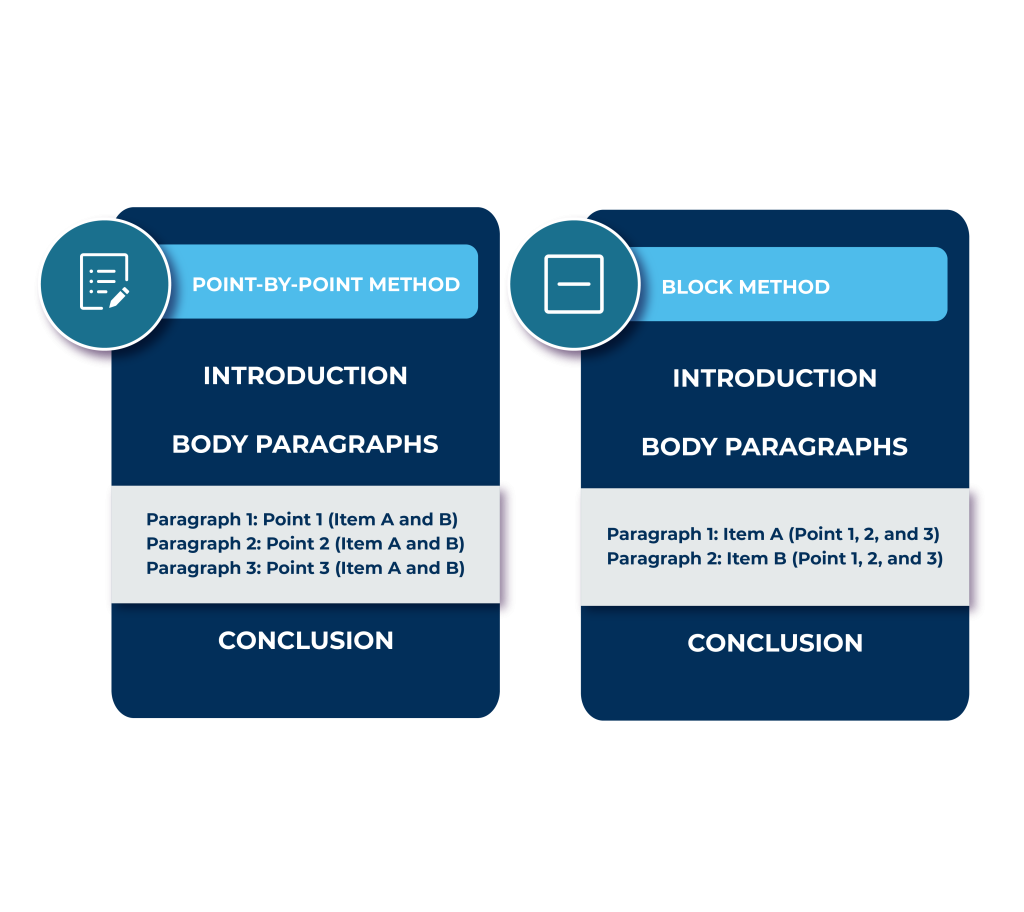A Writing Guide on Comparative Analysis Essay

In our daily lives, we constantly go through two thought processes, “Compare and Contrast.” We see things based on their similarities, or we compare them based on their similarities. While comparing things, we also see how certain things are different from each other or how they are contrasting. For instance, we compare brands, cars, jobs, TV shows, etc. A Comparative Analysis Essay aims to understand things more deeply and clearly or sometimes to make judgments about them.
A layman might not find the process of comparing and contrasting challenging, but writing an essay comparing two things can be truly difficult. But why worry when we’re here to help?
In this blog, you’ll find a writing guide for comparative analysis essays, including its structure, writing tips, suggested topics, and examples.
In this blog, you will find:
Defining a Comparative Analysis Essay
Comparative Analysis Essay, or Compare-and-Contrast Essay, is a type of essay that examines two or more subjects based on their similarities and differences. The subjects to compare could be things, events, concepts, places, people, literature, or any issue. This essay is mostly used in academia to analyze and evaluate various aspects of the subjects
Tips for Writing a Comparative Analysis Essay
There are some essential tips and tricks to follow in the process of writing a comparative analysis essay:
- Choose a relevant and exciting topic
- Develop a well-defined thesis statement
- Decide the aspects for comparison or the comparative framework
- Use a consistent structure/method of comparison
- Give a balanced analysis for both subjects
- Try using transitions and phrases for compare and contrast, like, however, on the contrary, on the other hand, etc.
- Be objective and analytical
- Insert evidence and examples
- Keep coherence
- Revise and Proofread
Outline for a Comparative Analysis Essay
A well-structured comparative analysis essay can add a better impression to your writing. Therefore, it is essential to understand how you structure a comparative analysis essay and how its outline would likely look. The structure of the written material is as critical as the quality of the material. A well-organized comparative essay is more convenient for the readers to comprehend.
The basic outline for a comparative essay includes:
Introduction
In the first part of the comparative essay, the author gives a brief introduction to the subjects to be compared. This includes a thesis statement that provides an overview of the points of comparison.
Body Paragraphs
The body paragraph of a comparative analysis essay contains primary information and details on the subjects’ similarities and differences. The Body part of the essay includes various paragraphs in which the subjects are compared or contrasted. Each section focuses on the points or aspects for comparison.
The underlying two main methods are the ones in which you can structure the body paragraphs of your comparative essay.
Point-by-Point Method:
The point-by-point method, also known as the alternating method, compares the items or points of the subjects. Each body paragraph in this structure would contain a unique point or item to be compared. Let’s say we are to compare two movies. In the point-to-point method, the first body paragraph will discuss both the movies’ cinematography and lighting. Both movies’ these aspects are compared and contrasted. In the next paragraph, we can compare their dialogues, scene settings, etc.
Block Method:
In this method, the subjects we compare are divided into paragraphs. We will then discuss all the aspects of one subject first, and then in the next paragraph, all the aspects of the second subject are discussed. For instance, if we take the same previous example, we will discuss the first movie’s aspects like cinematography, lighting, dialogues, scene settings, etc. in one paragraph while all the aspects of the second movie will be in another paragraph.
This method is comparatively easier than the point-by-point method.
Conclusion
The conclusion summarizes the key similarities and differences between the subjects, discusses the significance of the comparison, and explains how this comparison can help readers understand the subjects clearly.
An Example of a Comparative Essay
The underlying essay is a sample on “Owning Your Home or Renting an Apartment”.
Owning a home is an important matter, while for some people, renting an apartment is way more convenient. Therefore, it is always debated how good it is to own a home or rent an apartment. Financial, personal, or lifestyle considerations often influence the decision to own a home or rent an apartment. In both cases, there are pros and cons.
It sounds quite comforting when you say you have your own home as you feel that sense of ownership. In most cases, it is a relief to own your own home as you are free to treat your home in whatever way you want. You can paint it anytime you want. You can decorate it as per your wish. On the other hand, you do not have such freedom while renting a home. You cannot paint the home without the owner’s permission. A scratch on the rented home’s wall by your child might become a major headache for you because the owner would not accept that treatment to his home by you. The bedroom you sleep in might not be yours tomorrow when the owner finds another tenant.
While considering financial aspects of housing choice, renting is often better than buying. This is because renting an apartment costs less. There is a lower initial cost except for a limited security deposit and the first month’s rent, and there are no heavy repair expenses. On the contrary, owning a home requires an upfront investment, a heavy mortgage with interest, property taxes, and many other expenses.
In short, deciding on housing needs to consider many factors, including mobility, freedom, and financial implications. Understanding these factors can help one make a sound housing choice.
Comparative Literature Analysis Example Essay of Two Novels
Comparing “The God of Small Things and The Kite Runner”
Introduction
“The God of Small Things” and “The Kite Runner” are phenomenal novels of all time by Arundhati Roy and Khaled Hosseini, respectively. Both novels have similar points to discuss like themes of family and societal hierarchies. The novels are from two very different cultural settings i.e. India and Afghanistan. This essay will compare both novels based on their themes, character development, and cultural settings.
Body
The common themes in both novels discussed are family & relationships, and societal & cultural backgrounds. The authors depict family dynamics as crucial in building the characters’ narratives in “The God of Small Things” and “The Kite Runner”. The novels have characters from the elite class of society as well as from the lower class. Moreover, the novels show how the cultural settings and societal hierarchy shape and affect the characters’ lives. In Roy’s novel, she highlights the Indian caste system, and how these rigid social structures dictate characters’ personal relationships. In The Kite Runner, Hosseini depicts the ethnic hatred between Hazaras and Pashtuns, and how this ethnic hierarchy causes characters’ internal conflicts and moral dilemmas.
In “The God of Small Things” the main characters are the twins, “Rahel and Estha” who are portrayed as victims of their childhood trauma and social expectations. The characters would then have growth and resilience over the face of society, and the lasting impact of their childhood experiences. On the other hand, Hosseini in “The Kite Runner” highlights Amer as the main character who is a flawed yet relatable character. He shows how Amir grows from a self-centered boy to a compassionate adult.
The cultural setting used in Roy’s novel depicts the settings of Kerala India with the complexity of the Ipe Family’s dynamic. Roy has vividly described the cultural setting. Hosseini has shown Afghanistan as the cultural setting in his novel. It shows Kabul’s depiction before and after the Soviet invasion providing an account of societal and personal conflicts.
Conclusion
These two novels are powerful narratives about the family system, societal hierarchy, and self-guilt. While both novels highlight how childhood experiences shape adult life, they also offer how self-guilt leads to forgiveness. Through beautifully driven cultural settings and character development, both novels invite readers to reflect on the complexities of human relationships and life in society.
Essay Topics For Comparative Analysis
- Theory of Religion Vs Atheism
- Mind/Body Dualism
- Artificial Intelligence or Human Intelligence
- Apple Vs Android
- Capitalism Vs Marxism
- Cold War Vs Conventional War
- Following the cultural norms or breaking cultural taboos
- Living a hustle-free life in a village or modern life in a city
Read More:-
For more insights, check out our remarkable article on Visual Analysis Essays, which includes a sample. If you’re interested, give it a read!

